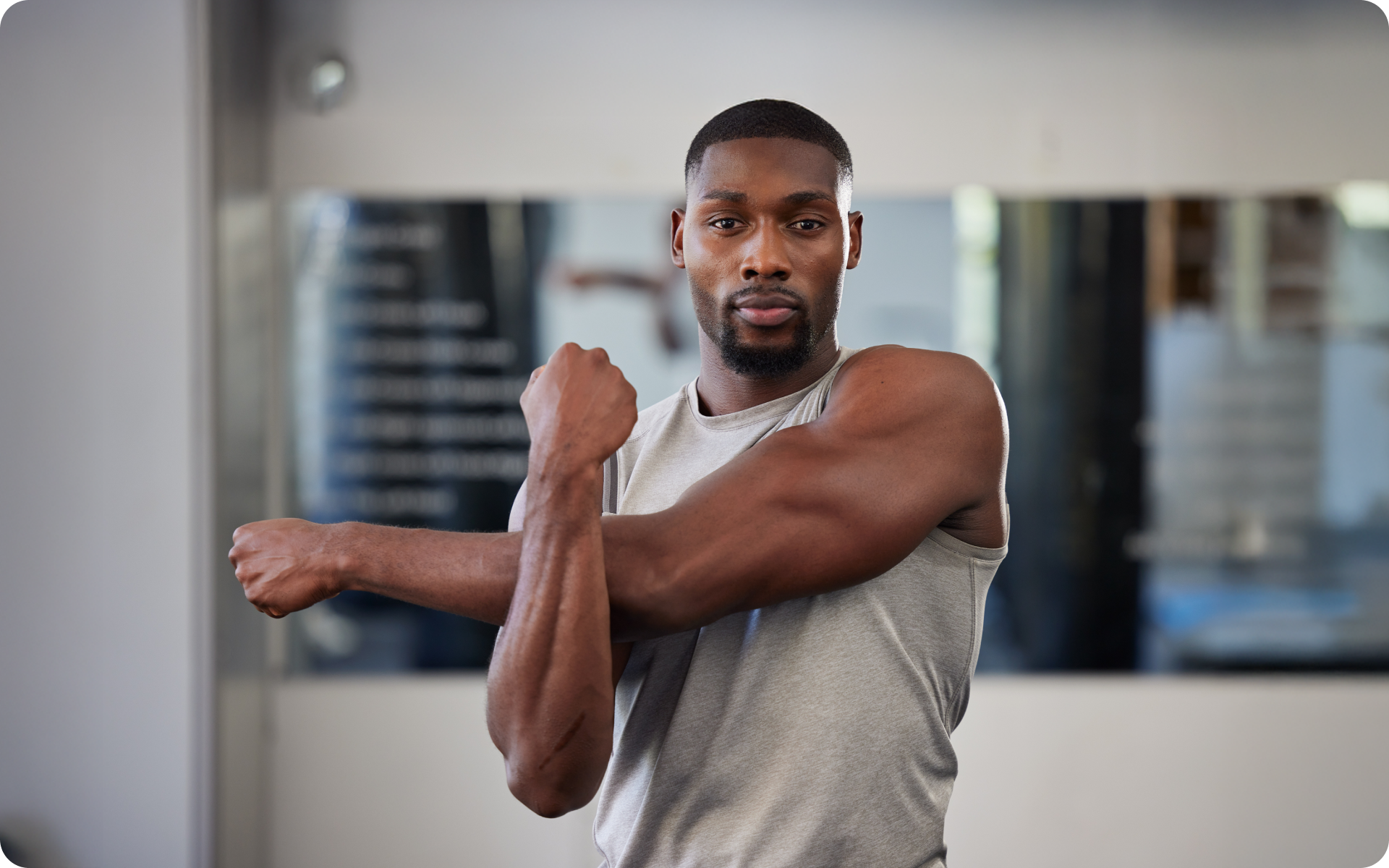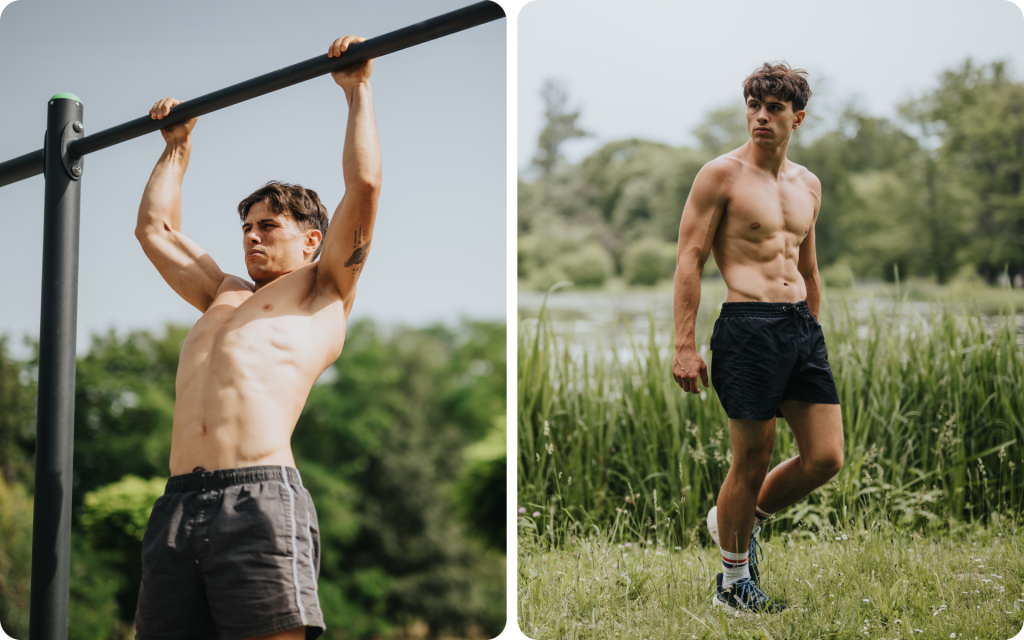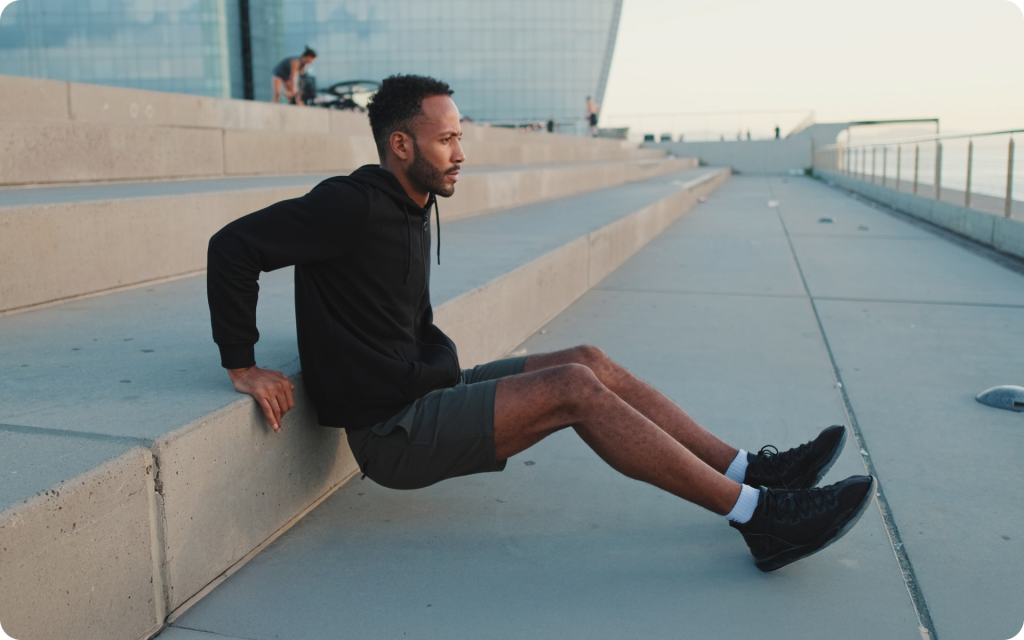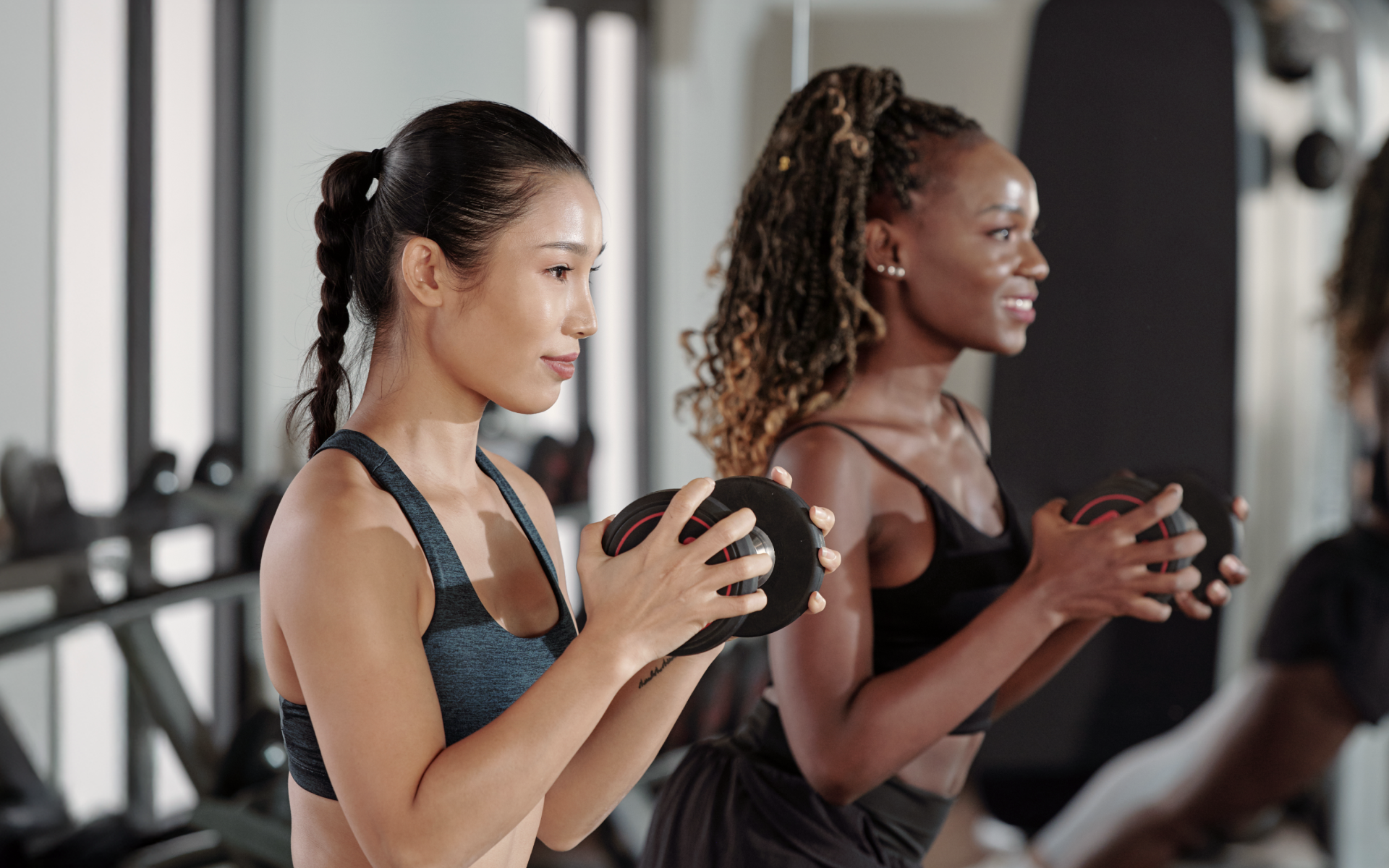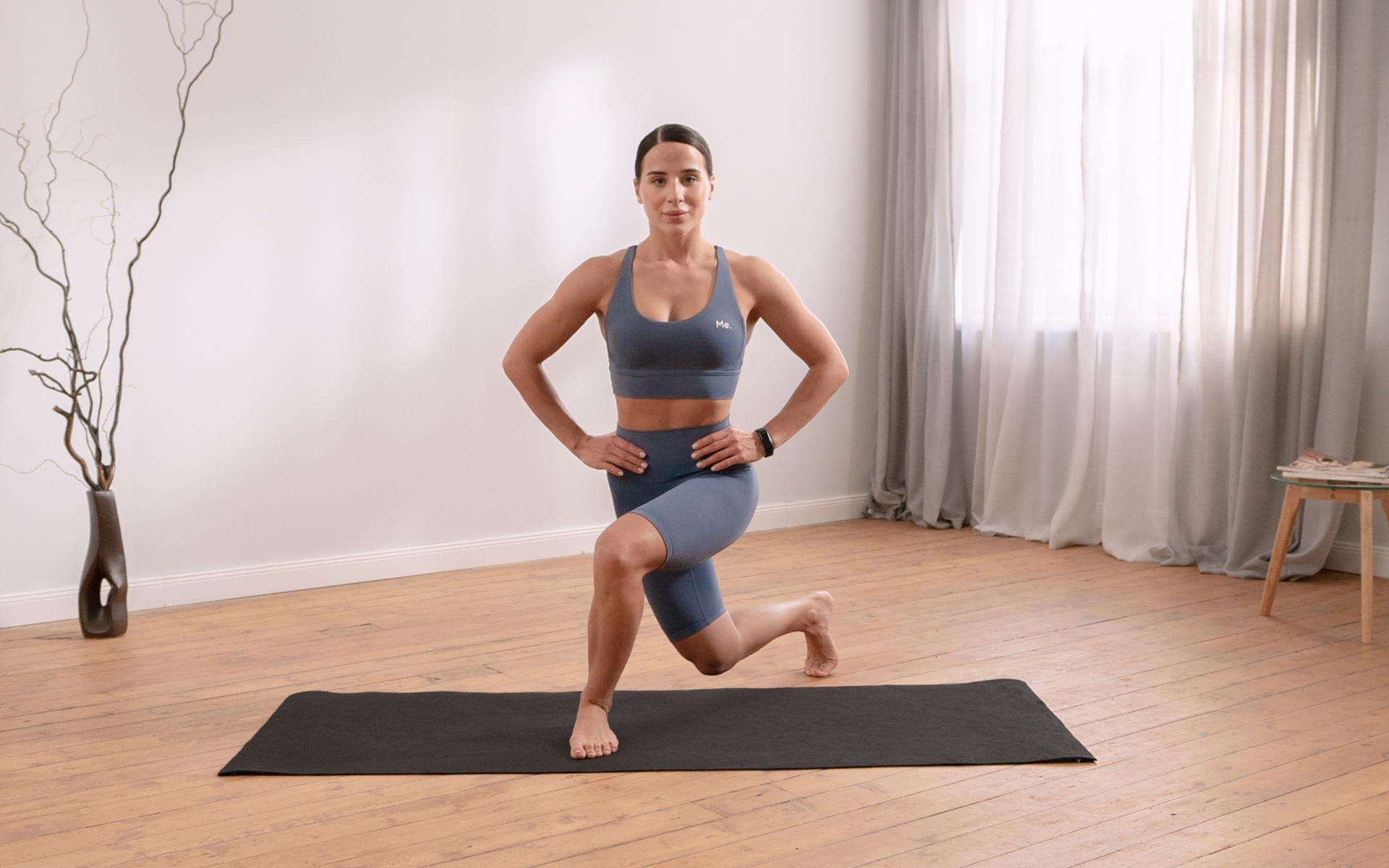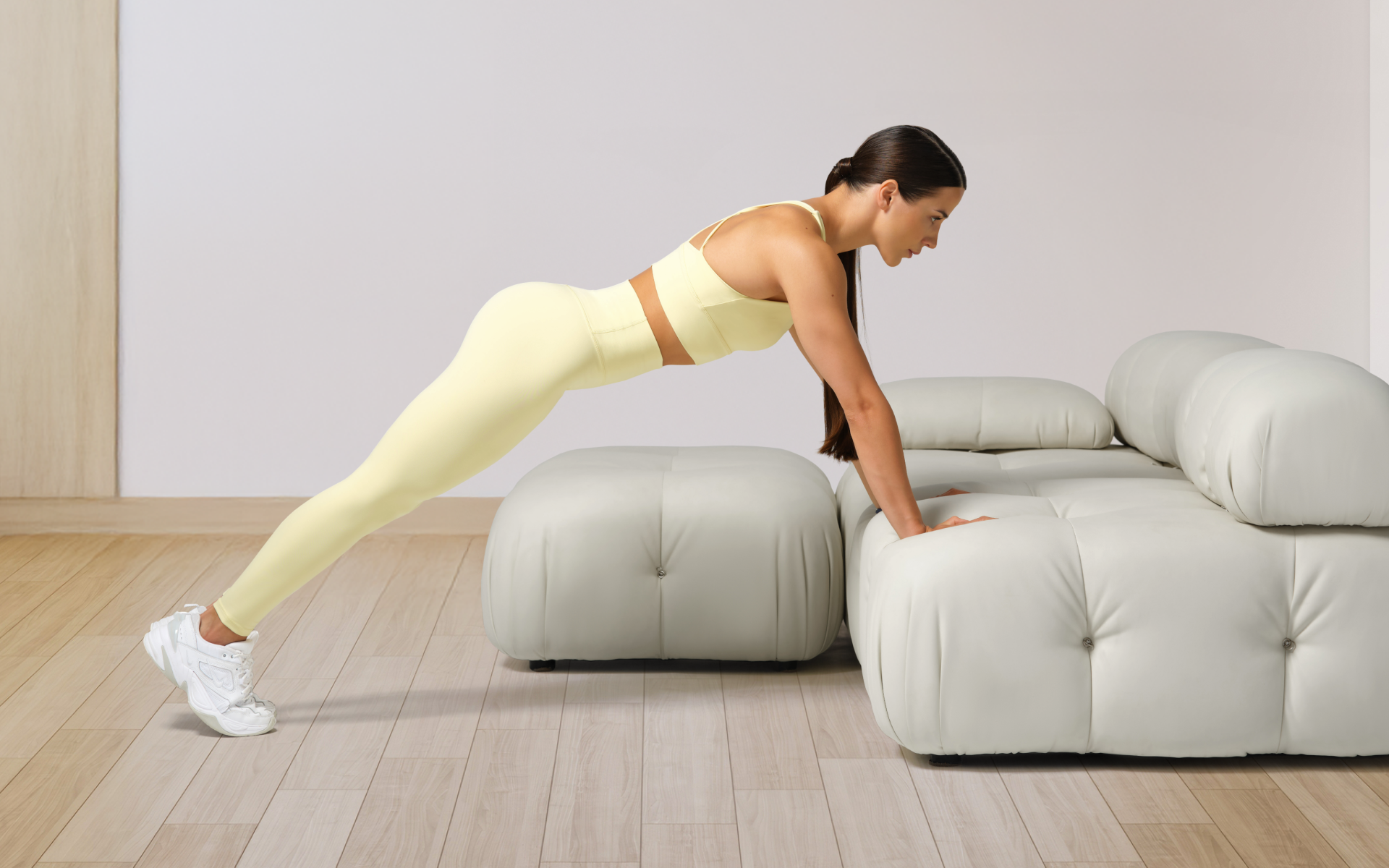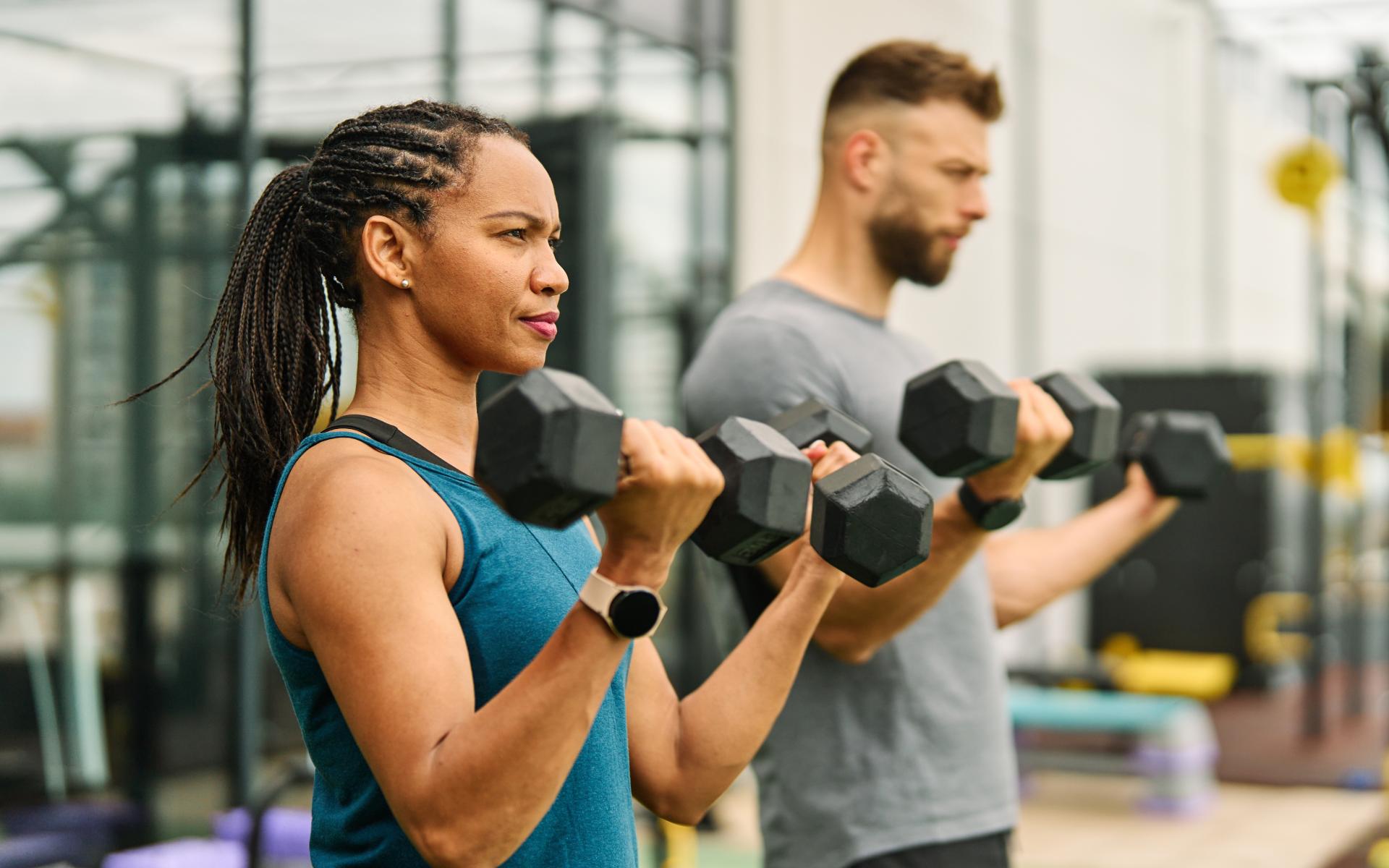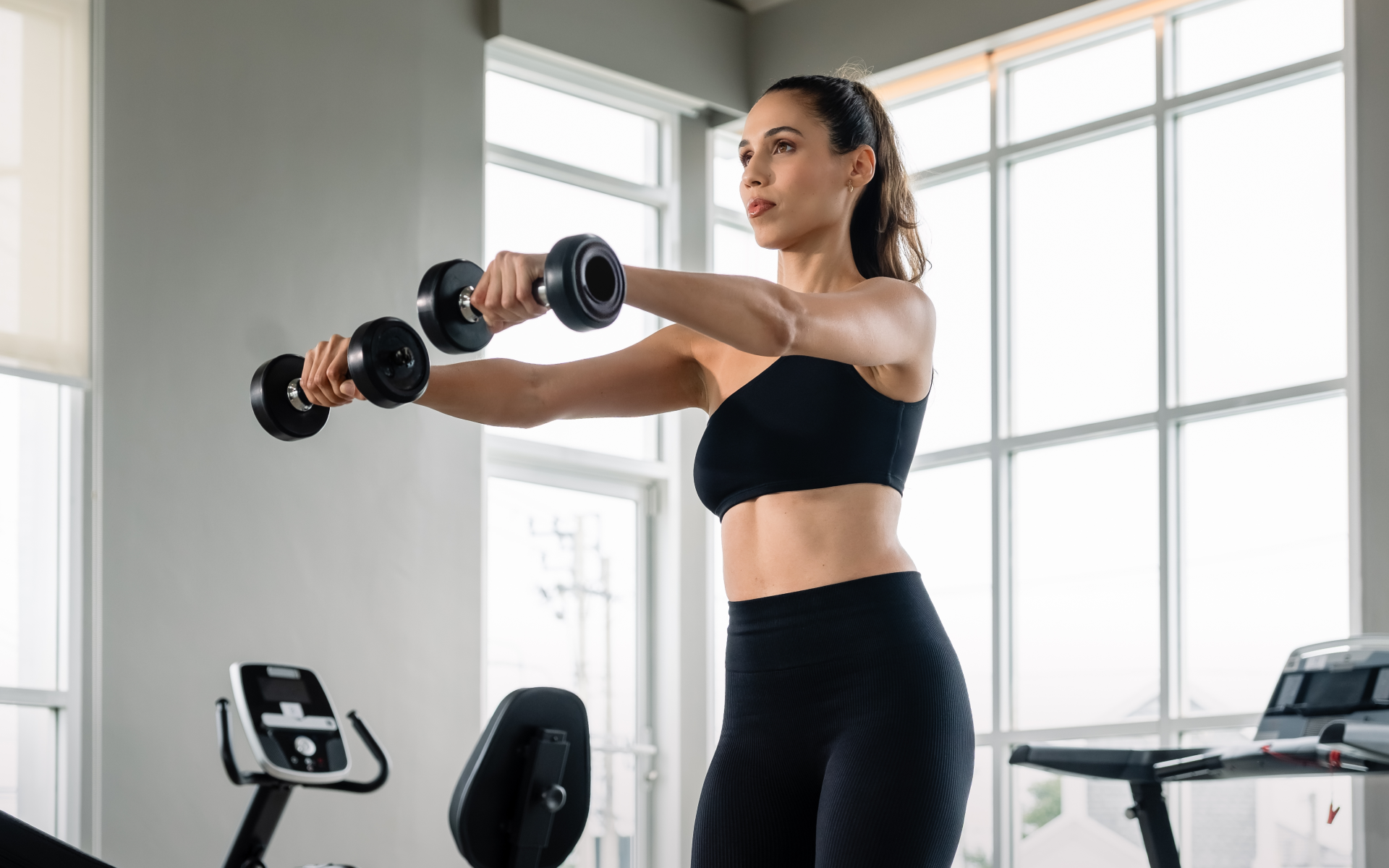Your chest muscles (pectoralis) assist with powerful pushing movements, such as when you shove a heavy door. Your back muscles (lats, traps, and rhomboids) support pulling actions, such as lifting a bag of groceries. And your shoulder muscles (the deltoids) stabilize your arms and help with a wide range of movements (1).
Together, these muscles don’t just help you move efficiently; they also protect your joints and reduce the risk of injury (1).
A well-rounded workout for these muscle groups optimizes both your strength and aesthetics, while also enhancing your body’s overall feel and performance. Whether you’re training for strength, tone, or stamina, incorporating muscular endurance exercises into your routine ensures you build resilience, not just size.
So, what is a targeted upper body workout for men?
This guide walks you through 7 practical exercises, carefully chosen to build your chest, back, and shoulders. You’ll learn how to execute each move with proper form and understand why it works. By the end, you’ll have a clear roadmap to building a functional, strong, and sculpted upper body — even if you’re working with upper body bodyweight exercises at home.
How Can I Train My Upper Body Fast?
The upper body muscles (including the chest, back, and shoulders) respond well to targeted resistance training, but there are no shortcuts.
Progress comes down to using the right strategies, training consistently, and allowing time for recovery.
Below, we’ll explore key components of an effective upper body program, breaking down what science tells us about improving strength and size efficiently.
Focus On Progressive Overload
One of the most crucial principles in strength training is the concept of progressive overload. This progression means gradually increasing the demands placed on your muscles to encourage them to grow stronger (2). Your body adapts when it’s consistently pushed just beyond its current capabilities.
To achieve progressive overload, you can:
- Increase the weight load over time.
- Perform more repetitions or sets.
- Improve your form and control during exercises.
- Decrease rest times between sets (to a reasonable degree).
Remember, small, consistent improvements make the most significant difference.
Overloading too quickly can lead to injuries.
Train Each Muscle Group 2–3 Times A Week
Research indicates that training each muscle group multiple times a week is more effective for building strength and size than training them only once (3, 4). The upper body is no exception.
Instead of dedicating one entire day to chest or back exercises, incorporate these muscle groups into your weekly routine more frequently.
For example, an upper body split routine can include:
- Day 1: Chest, shoulders, and triceps
- Day 2: Back and biceps
- Day 3: Rest or active recovery
- Day 4: Upper body focus again
This workout schedule ensures that each upper body muscle group receives sufficient work while allowing for adequate recovery between sessions.
When it comes to weight loss, progress is made by inches, not miles, so it’s much harder to track and a lot easier to give up. The BetterMe: Health Coaching app is your personal trainer, nutritionist, and support system all in one. Start using our app to stay on track and hold yourself accountable!
Incorporate Compound And Isolation Exercises
A well-rounded program balances compound exercises and isolation exercises.
- Compound exercises work multiple muscle groups at once, making them effective for saving time (5). Examples include the bench press, pull-ups, and rows.
- Isolation exercises focus on a specific muscle, improving balance and aesthetics (6). Examples include bicep curls or lateral raises.
By combining these, you train for both functionality and definition.
Compound exercises should form the foundation of your workout, while isolation exercises refine the details.
Prioritize Recovery For Faster Results
Muscles don’t grow during workouts; they rebuild during recovery.
Overtraining or skipping rest can slow your progress (7).
Recovery strategies include:
- Getting sufficient sleep (7–9 hours per night).
- Eating a balanced diet with enough protein (roughly 1.6–2.2 grams per kilogram of body weight).
- Giving muscles 48–72 hours of rest before training them again.
Stretching, light activity, and foam rolling can also help alleviate soreness and keep your muscles ready for the next session.
Use Proper Technique To Avoid Injury
While it’s tempting to lift heavier for faster results, sacrificing form can lead to setbacks.
Proper technique works the targeted muscles more effectively and prevents unnecessary strain on joints (8).
Take time to learn correct positioning for each exercise. If you’re unsure, working with a personal trainer, even temporarily, can make a huge difference.
Track Your Progress
Monitor your workouts to stay consistent and ensure progress over time.
Whether it’s through weight lifted, reps performed, or muscle measurements, tracking helps highlight what’s working and where you need to adjust.
Be Patient, Stay Consistent
Even with the best plan, muscle growth doesn’t happen overnight.
The body needs time to adapt and build strength (9). Structured effort, quality movements, and smart recovery are your best tools for a strong, defined upper body.
Read more: Military Calisthenics Workout: Building Strength, Endurance, and Agility with Bodyweight Exercises
How Many Exercises Should I Do For Upper Body Strength?
Many wonder how many exercises you include in an upper body workout for men at home or in the gym.
“Is 5 exercises for upper body enough, or do you need more or less?
For most people, including 4-6 exercises in an upper body workout schedule, strikes a good balance. This amount usually ensures you target all major muscle groups without overloading your session.
Here’s how this workout might look:
- 2–3 compound exercises (e.g., bench press, pull-ups, rows).
- 1–2 isolation exercises per target muscle group (e.g., lateral raises, triceps pushdowns).
This approach creates a well-rounded workout by engaging multiple muscles simultaneously while still targeting key areas individually.
The number of exercises you choose should reflect what you’re trying to achieve:
- Building Size and Strength: If your focus is developing bigger, stronger muscles, prioritize a few high-quality compound movements. Compound exercises recruit the most muscle fibers, making them more efficient for growth (5).
- Balancing Weaknesses or Aesthetics: If you want to fine-tune specific areas, additional isolation exercises can help (6). For example, adding bicep curls if your arms need more attention, or rear-delt flies to improve shoulder balance.
Experience Level Matters
- Beginner lifters should stick to fewer exercises, around 3-4 per session.
This amount allows you to focus on mastering form and avoiding fatigue.
- Advanced lifters, who can handle higher volumes, choose 5-6 exercises or more, depending on their tolerance and goals.
Recovery and Volume
Your recovery capacity plays an important role. It’s not just about how many exercises you can do in one session, but how well your body recovers afterward (7). If you’re feeling sore for days or your performance is plateauing, it may be a sign that you’re overexerting yourself.
Aim for 10-20 total sets per muscle group each week, split across at least 2 sessions.
For example, if your workout includes chest and back exercises, distribute the sets across different exercises, such as bench press, incline press, and barbell rows.
Quality Over Quantity
More exercises don’t always mean better results. What matters is the quality of your movements. Performing a few exercises with proper form and full effort is more effective than rushing through too many.
Take your time with each set.
Focus on:
- Maintaining good posture
- Performing controlled reps
- Engaging the correct muscles
This focus ensures you’re making the most of every motion.
Adjust Based On Feedback
Your workout should evolve with your needs. Keep track of how your body feels and responds:
- Are you recovering well between sessions?
- Are you progressing in strength and size?
- Do specific muscles feel neglected or overworked?
You can modify the number of exercises, sets, or the frequency of your sessions as needed.
Is 5 Upper Body Exercises Enough?
Five exercises can provide a solid upper body workout, but whether it’s enough depends on how those exercises are chosen and structured.
The key is ensuring they cover the major muscle groups effectively, align with your training goals, and fit your level of experience.
The upper body consists of multiple key muscle groups:
- Chest (Pectorals): For pushing movements.
- Back (Lats, Traps, and Rhomboids): For pulling strength.
- Shoulders (Deltoids): For stability and arm movement.
- Arms (Biceps and Triceps): For supporting many upper body actions.
- Traps and Rear Delts: Stabilizers and posture-enhancers.
To create balance, a workout with 5 exercises should strategically involve all of these areas. Compound exercises are most effective, as they engage multiple muscle groups simultaneously. This multiple engagement factor allows you to work more muscles efficiently.
Structuring A 5-Exercise Workout
A sample workout structure for 5 exercises could look like this:
- Bench Press: Focuses on the chest, triceps, and front shoulders.
- Pull-Ups or Lat Pulldowns: Works the lats, biceps, and rear shoulders.
- Overhead Press: Targets the shoulders and triceps for pushing strength.
- Bent-Over Rows: Hits the back, traps, and rear shoulders.
- Bicep Curls or Triceps Extensions: Isolates one smaller muscle group to ensure balance.
This setup prioritizes both compound and isolation exercises, targeting all major muscle groups.
For beginners, 5 exercises are sufficient to:
- Build strength
- Master proper form
- Improve muscle coordination
Since newcomers are less experienced, they can achieve noticeable results with fewer, well-chosen movements.
Intermediate and advanced lifters, however, may need to expand their workouts over time. As the body adapts and training goals become more specific, a more experienced lifter may need to add more isolation exercises to target weaker areas, such as the side delts or the upper traps.
What Is The Most Transformative Upper Body Workout For Men?
A well-designed upper body workout effectively targets all major muscle groups.
These upper body workouts begin with a proper warm-up to reduce injury risk and enhance performance. Below is a structured workout plan, coupled with detailed instructions for each exercise.
Warm-Up (5–10 Minutes)
Before jumping into heavy lifting, a dynamic warm-up is essential. It increases blood flow, wakes up your muscles, and reduces joint stiffness.
Here’s a quick routine:
Arm Circles
- Stand tall with your arms extended out to the sides, forming a “T.”
- Begin making small, controlled circles forward. Gradually increase size.
- After 20 seconds, reverse the direction for another 20 seconds.
This movement helps warm up the shoulder joints, promoting mobility and reducing the risk of injury.
Scapular Push-Ups
- Begin in a high plank position, keeping your core tight.
- Without bending your elbows, pinch your shoulder blades together and lower your torso slightly.
- Push through your palms to return to the starting position.
This exercise activates the shoulder stabilizers and strengthens the scapular muscles.
Band Pull-Aparts
- Hold a resistance band with both hands, arms extended in front of you.
- Pull the band outward, squeezing your shoulder blades together.
- Return to the start position with control.
Now that you’re warmed up, here’s the workout.
The Workout Program
- Bench Press (Chest, Shoulders, Triceps)
- Bent-Over Rows (Back, Traps, Rear Deltoids)
- Lat Pulldowns (Back, Biceps)
- Overhead Press (Shoulders, Triceps)
- Incline Dumbbell Curls (Biceps)
- Triceps Dips (Triceps, Chest)
- Face Pulls (Rear Deltoids, Traps)
1. Bench Press
The bench press is a staple for developing chest strength and size while also engaging the shoulders and triceps.
Steps:
- Lie on a flat bench with your feet flat on the floor. Grip the barbell slightly wider than shoulder-width.
- Lower the bar slowly to your chest, keeping your elbows at a 45-degree angle.
- Push the bar back up to the starting position without locking your elbows.
- Perform 3 sets of 8–10 reps.
2. Bent-Over Rows
Bent-over rows strengthen the back, traps, and rear shoulders while improving posture.
Steps:
- Hold a barbell with an overhand grip, hands shoulder-width apart.
- Bend at the hips, keeping your back straight, and lower the barbell towards the floor.
- Pull the barbell to your lower chest by squeezing your shoulder blades.
- Lower the bar back to the starting position.
- Perform 3 sets of 8–10 reps.
3. Lat Pulldowns
Lat pulldowns target the back muscles, specifically the latissimus dorsi (lats) and rhomboids.
Steps:
- Sit on a machine with your feet flat on the floor. Grip the bar with your hands shoulder-width apart.
- Pull the bar towards your chest while keeping your elbows close to your sides.
- Slowly release the bar back up to the starting position.
- Perform 3 sets of 8–10 reps.
4. Overhead Press
The overhead press is excellent for the shoulders and triceps, promoting upper body stability.
Steps:
- Stand with your legs hip-width apart, back straight, and hold a barbell at shoulder height with your palms facing forward.
- Press the bar overhead, fully extending your arms.
- Lower the bar back to the starting position without letting it rest on your chest.
- Perform 3 sets of 8–10 reps.
Reasons why BetterMe is a safe bet: a wide range of calorie-blasting workouts, finger-licking recipes, 24/7 support, challenges that’ll keep you on your best game, and that just scratches the surface! Start using our app and watch the magic happen.
5. Incline Dumbbell Curls
This exercise isolates the biceps, targeting the long head of the biceps for a fuller look.
Steps:
- Sit on an inclined bench with dumbbells in each hand and arms fully extended.
- Curl the weights up towards your shoulders, keeping your elbows stationary.
- Slowly lower the dumbbells back to the starting position.
- Perform 3 sets of 10–12 reps.
6. Triceps Dips
Triceps dips effectively build the back of your arms while engaging the chest.
Steps:
- Position your hands on parallel bars, supporting your weight with your arms extended.
- Lower your body by bending your elbows until they’re at a 90-degree angle.
- Push back up to the starting position.
- Perform 3 sets of 8–10 reps.
7. Face Pulls
Face pulls are a great finishing exercise for strengthening the rear deltoids and traps, promoting shoulder health.
Steps:
- Attach a rope to a head-high cable pulley.
- Hold the rope with both hands, palms facing each other.
- Pull the rope towards your face while squeezing your shoulder blades together.
- Slowly return to the starting position.
- Perform 3 sets of 12–15 reps.
Cool-Down
A proper cool-down is essential after an intense upper-body session.
It helps your muscles relax, improves flexibility, and kick-starts recovery by increasing blood flow.
Child’s Pose Stretch
- Kneel on the floor with your knees wide and your toes touching.
- Sit back onto your heels and extend your arms forward, lowering your chest toward the ground.
- Relax your shoulders and hold the stretch for 20–30 seconds.
Chest Stretch
- Stand tall near a doorway or wall.
- Place one arm against the wall at a 90-degree angle to your body.
- Slowly turn your body away from the arm until you feel a stretch in your chest.
- Hold for 20–30 seconds, then switch to the other side.
Overhead Triceps Stretch
- Raise one arm overhead, bending your elbow so your hand reaches between your shoulder blades.
- Use your opposite hand to gently push the bent elbow back.
- Hold for 20–30 seconds, then switch to the other arm.
Cross-Body Shoulder Stretch
- Extend one arm across your chest at shoulder height.
- Use your opposite hand to gently pull the stretched arm closer to your chest.
- Hold the stretch for 20–30 seconds, then switch to the other side.
Which Muscles Should Not Be Trained Together?
There’s no rule that you cannot train specific muscles simultaneously.
However, how you pair muscle groups in a workout can impact efficiency, performance, and recovery.
Combining muscles that work together or are anatomically close can make a workout more effective.
For example:
- Push muscles (chest, shoulders, triceps) are naturally activated in movements like bench presses.
- Pull muscles (back, biceps, rear shoulders) work together during rows and pull-ups.
Pairing those muscle groups aligns with how the body moves, optimizing energy and workload distribution.
Some pairings, although possible, may not always be the most practical.
For instance:
- Chest and Back in One Session: Training two large muscle groups (both requiring significant energy) can lead to fatigue. You may not fully engage each muscle group, reducing overall effectiveness.
- Shoulders with Chest or Back: The shoulders play a crucial role in many pressing (push) or pulling (pull) movements. If you train them alongside the chest or back, they might fatigue too early, limiting your performance in those areas.
These combinations require careful planning around exercise order and volume.
Best Practices For Muscle Pairing
1. Pair Complementary Groups
It’s often efficient to combine:
- Push Day: Chest, shoulders, triceps.
- Pull Day: Back, biceps, traps.
This approach ensures that your engaged muscles are working together during exercises in the same session.
2. Alternate Push and Pull for Total Upper Body Workouts
An upper body workout that combines push and pull muscles is excellent.
Alternating push and pull exercises (e.g., bench press followed by rows) allow one group to recover while the other works.
3. Avoid Unnecessary Overlap
Training the same or overlapping muscles across consecutive exercises or days can reduce recovery time and increase the risk of injury.
For example:
- Training your shoulders and chest together on consecutive days may overwork your shoulders, reducing performance and recovery ability.
4. Monitor Recovery
Regardless of the pairing you choose, make recovery a priority. Muscles need time to repair. Without this, progress stalls, and fatigue builds up.
Read more: This Is How A Toned Body For Men Looks Like, According To Science
Is 20 Minutes Enough For Upper Body Workout?
It’s possible to get a good upper body workout in 20 minutes, but your approach matters. Short sessions are most effective when they focus on intensity and efficiency.
Research suggests that resistance training volume (the total number of sets and reps) determines muscle growth more than workout duration. If you use compound exercises and minimize rest, 20 minutes can effectively target multiple muscle groups.
Example 20-Minute Workout:
- Bench Press (3 sets): Targets chest, shoulders, triceps.
- Pull-Ups (3 sets): Hit back, biceps, and rear shoulders.
- Overhead Press (2 sets): Focuses on shoulders and triceps.
Keep rest periods short (30–60 seconds) to maintain intensity.
Longer sessions are more effective for advanced goals, such as isolating smaller muscles or increasing total training volume. For example, sculpting shoulder detail with lateral raises or face pulls requires additional time.
Is It Ok To Do Upper Body Workout For Men Everyday?
Training your upper body every day isn’t ideal for most people. Muscles need time to recover, rebuild, and grow after resistance training.
Muscle recovery occurs during rest periods, not during the workout itself.
When you train, muscle fibers develop tiny tears. Recovery time allows these fibers to repair and grow stronger. Skipping recovery increases the risk of overuse injuries, fatigue, and stalled progress.
Studies show that training a muscle group 2–3 times a week is optimal for muscle growth. This amount of training allows for sufficient stimulus without overtraining.
Training daily doesn’t provide enough recovery for major muscle groups, such as the chest or back.
If you vary intensity and focus on smaller muscle groups, it is possible to train daily:
- Day 1: Chest-focused (e.g., bench press, push-ups).
- Day 2: Back-focused (e.g., pull-ups, rows).
- Day 3: Shoulders and arms.
Even with this approach, most experts recommend at least one full rest day per week to avoid burnout.
To build muscle, aim for 6–12 reps per set. This range is optimal for hypertrophy (muscle growth) because it provides enough tension and volume to stimulate muscle fibers effectively. Perform 3–4 sets with controlled movements and proper form for best results. No, lifting dumbbells every day isn’t ideal for most people. Muscles require 48–72 hours to recover fully after strength training. Overtraining can lead to fatigue, decreased performance, and an increased risk of injury. Instead, train each muscle group 2–3 times a week, alternating focus areas. Lift weights that challenge you while maintaining proper form. A good rule of thumb is to use 70–85% of your one-rep max for 6–12 reps. This percentage ensures the load is heavy enough to promote hypertrophy but not so heavy as to compromise proper technique. Not necessarily. For hypertrophy, 5 sets of 12 reps is a high-volume approach that can be effective if you condition for it. However, it may be excessive for beginners or if you struggle to manage recovery, intensity, and workout duration well. Adjust the sets and volume based on your fitness level and recovery ability.Frequently Asked Questions
How many reps to build muscle?
Can I lift dumbbells every day?
How heavy should I lift?
Is 5 sets of 12 reps too much?
The Bottom Line
Upper body workout for men is all about blending practical exercises, proper technique, and tailored recovery strategies. By focusing on balanced training that targets all major muscle groups, you can build strength, improve muscle definition, and boost overall performance.
Remember to use the proper exercise structure, alternating between push and pull movements, and avoid overtraining by incorporating adequate rest periods.
DISCLAIMER:
This article is intended for general informational purposes only and does not serve to address individual circumstances. It is not a substitute for professional advice or help and should not be relied on for making any kind of decision-making. Any action taken as a direct or indirect result of the information in this article is entirely at your own risk and is your sole responsibility.
BetterMe, its content staff, and its medical advisors accept no responsibility for inaccuracies, errors, misstatements, inconsistencies, or omissions and specifically disclaim any liability, loss or risk, personal, professional or otherwise, which may be incurred as a consequence, directly or indirectly, of the use and/or application of any content.
You should always seek the advice of your physician or other qualified health provider with any questions you may have regarding a medical condition or your specific situation. Never disregard professional medical advice or delay seeking it because of BetterMe content. If you suspect or think you may have a medical emergency, call your doctor.
SOURCES:
- The Upper Limb (2025, teachmeanatomy.info)
- Effects of Resistance Training Overload Progression Protocols on Strength and Muscle Mass (2024, pubmed.ncbi.nlm.nih.gov)
- Loading Recommendations for Muscle Strength, Hypertrophy, and Local Endurance: A Re-Examination of the Repetition Continuum (2021, mdpi.com)
- Twice-daily sessions result in a greater muscle strength and a similar muscle hypertrophy compared to once-daily session in resistance-trained men (2022, minervamedica.it)
- 5 Benefits of Compound Exercises (2016, acefitness.org)
- A Review of the Acute Effects and Long-Term Adaptations of Single- and Multi-Joint Exercises during Resistance Training (2016, link.springer.com)
- EXPLORING THE SCIENCE OF RECOVERY (n.d, blog.nasm.org)
- ~Benefits of Proper Form and Technique during~Resistance Training~ (n.d, walkitscience.org)
- Adaptations to Endurance and Strength Training (2018, pmc.ncbi.nlm.nih.gov)
